Papers by Roberto C Ambrosio
IFMBE Proceedings, 2019
This work proposes a non-invasive ultrasonic device for stimulation of the pelvic floor in women ... more This work proposes a non-invasive ultrasonic device for stimulation of the pelvic floor in women suffering from urinary incontinence (UI), which is an extremely common pathology in older women.
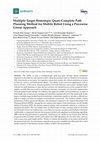
Sensors
The ability to plan a multiple-target path that goes through places considered important is desir... more The ability to plan a multiple-target path that goes through places considered important is desirable for autonomous mobile robots that perform tasks in industrial environments. This characteristic is necessary for inspection robots that monitor the critical conditions of sectors in thermal, nuclear, and hydropower plants. This ability is also useful for applications such as service at home, victim rescue, museum guidance, land mine detection, and so forth. Multiple-target collision-free path planning is a topic that has not been very studied because of the complexity that it implies. Usually, this issue is left in second place because, commonly, it is solved by segmentation using the point-to-point strategy. Nevertheless, this approach exhibits a poor performance, in terms of path length, due to unnecessary turnings and redundant segments present in the found path. In this paper, a multiple-target method based on homotopy continuation capable to calculate a collision-free path in a...
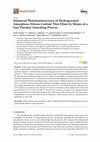
Materials
In this paper, the photoluminescence (PL) of hydrogenated amorphous silicon carbide (a-Si1−xCx:H)... more In this paper, the photoluminescence (PL) of hydrogenated amorphous silicon carbide (a-Si1−xCx:H) thin films obtained by Plasma Enhancement Chemical Vapor Deposition (PECVD) is reported. Strong PL is obtained after a fast annealing process for 60 s at temperatures of 200, 400, 600, and 800 °C. The thin films are characterized using Fourier Transform Infrared spectroscopy (FTIR), PL spectroscopy, and Energy-Dispersive X-ray Spectroscopy (EDS). According to the results of the structural characterization, it is deduced that a structural rearrangement of the amorphous matrix is carried out during the fast annealing process, which results in different degrees of oxidation on the a-Si1−xCx:H films. The PL peak position shifts towards higher energies as the temperature increases. The sample deposited with a silane/methane flux ratio of 37.5 at an Radio Frequency (RF) power of 6 W experiences an increase in PL intensity of more than nine times, with a displacement in the peak position from ...

Journal of Molecular Structure
Abstract Pentacene is an important semiconductor in the field of organic electronics. In this wor... more Abstract Pentacene is an important semiconductor in the field of organic electronics. In this work is presented an alternative synthesis procedure to obtain pentacene from 6,13-pentacenequinone as a precursor. Synthesis of pentacene was performed in two reactions, Diels-Adler cycloaddition of 6,13-pentacenequinone followed by 6,13-pentacenequinone reduction to pentacene, employing LiAlH4 as reducing agent. The products were characterized by Fourier Transform Infrared Spectroscopy (FTIR), 1H-Nuclear Magnetic Resonance Spectroscopy (1H-NMR), X-Ray Diffraction (XRD), Thermogravimetric Analysis (TGA) and Ultraviolet–Visible Spectroscopy (UV-VIS). In this work, 6,13-pentacenequinone was synthetized with a high yield (55%) using an alternative method. The optimization process resulted in an overall reduction of reaction time while exhibiting high yield. The method presented here provides an affordable pentacene synthesis route with high purity, which can be further applied for research and development of organic electronic applications.
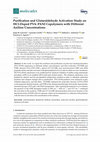
Molecules
In this work, we report the synthesis and purification of polyvinyl alcohol-polyaniline (PVA–PANI... more In this work, we report the synthesis and purification of polyvinyl alcohol-polyaniline (PVA–PANI) copolymers at different aniline concentrations, and their molecular (1H-NMR and FTIR), thermal (TGA/DTG/DSC), optical (UV–Vis-NIR), and microstructural (XRD and SEM) properties before and after activation with glutaraldehyde (GA) in order to obtain an active membrane. The PVA–PANI copolymers were synthesized by chemical oxidation of aniline using ammonium persulfate (APS) in an acidified (HCl) polyvinyl alcohol matrix. The obtained copolymers were purified by dialysis and the precipitation–redispersion method in order to eliminate undesired products and compare changes due to purification. PVA–PANI products were analyzed as gels, colloidal dispersions, and thin films. 1H-NMR confirmed the molecular structure of PVA–PANI as the proposed skeletal formula, and FTIR of the obtained purified gels showed the characteristic functional groups of PVA gels with PANI nanoparticles. After exposing...

CO2 hydraulic fracturing in oil wells is done to increase productivity of oil production by conne... more CO2 hydraulic fracturing in oil wells is done to increase productivity of oil production by connecting multiple oil pockets to the main oil well. Currently there is a need to understand and control with a high degree of precision the geometry, direction, and the physical properties, like pressure and temperature of such fractures, to ensure or increase the probability of connection of the oil pockets to main well(s). The current state of the art in hydraulic fracture characterization does not meet the requirements of the oil industry. In Mexico0 SENER-CONACyT recently supported a three party collaborative effort between the Mexican Petroleum Institute, Schlumberger Dowell Mexico, and the Autonomous University of Juarez to develop a sensing scheme to measure physical parameters of a hydraulic induced fracture like, but not limited to Pressure, Temperature, Density and Viscosity, including the improvement of methods and techniques for the mapping of hydraulic fracturing. We present in...
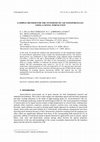
Chalcogenide Letters
In this work, we present the synthesis and characterization of CdS nanoparticles suitable for sem... more In this work, we present the synthesis and characterization of CdS nanoparticles suitable for semiconductor applications using a simple and manufacturable process. The solution based process was synthetized at room temperature using cadmium nitrate tetrahydrate (Cd (NO3)2 .4 H2O 0.1 M) and a Thioacetamide (C2H5NS (TA) 0.5 M) as source of cadmium and sulfur, respectively. The effect of the concentration of polyethyleneimine (PEI) as a surface stabilizer or surfactant for growth control of CdS nanoparticles was studied. The PEI concentrations were varied as 1 M, 0.5 M , 0.25 M , and 0.01 M respectively. Optical properties of CdS were analyzed by UV-Vis spectroscopy; functional groups were identified by Fourier transform infrared spectroscopy (FTIR) and the surface morphology by scanning electron microscopy (SEM). The particle size for CdS nanoparticles were less than 80 nm. An increase in size was observed inversely to the PEI concentration.

Nowadays, reliability life-stress models have been marked under the assumption that stress level ... more Nowadays, reliability life-stress models have been marked under the assumption that stress level must be constant during device performance. But actual models do not work efficiently when stress factor is variable. Thus in this paper is presented a Reliability Life-Stress voltage model which incorporates electrical harmonics effects modeled by compact form of Fourier series. The proposed model is developed by combating Cumulative Damage Model and Inverse Power Law. The parameters of the model are estimated using maximum likelihood. A case study for residential devices with high harmonic generation rate is presented. Since, for an electrical and electronic device failure times follow exponential distribution, in this paper, the time varying stress which based in Markov’s properties is traded as equivalent constant stress. The Model application shows the performance of equipment submitted by electrical harmonics and determines the reliability indexes better than constant life-stress r...
ABSTRACT El presente trabajo presenta el diseño y análisis de un capacitor variable MEMS (Micro E... more ABSTRACT El presente trabajo presenta el diseño y análisis de un capacitor variable MEMS (Micro Electro Mechanical Systems) de placas paralelas, el cual es controlado por actuadores térmicos. Presentamos también una alternativa para la medición de pequeños cambios en la capacitancia en dispositivos MEMS, la cual fue implementada en las pruebas experimentales del capacitor variable usando el dispositivo programable CI MS3110 que genera una salida en voltaje lineal lo cual hace muy fácil medir la capacitancia, el cual se programo con respecto a la capacitancia esperada de este diseño.

2016 IEEE 43rd Photovoltaic Specialists Conference (PVSC), 2016
Nowadays the unmanned aerial vehicles (UAV) have received attention as a tool for the human and m... more Nowadays the unmanned aerial vehicles (UAV) have received attention as a tool for the human and military applications, such as monitoring, surveillance and also in the development of sensors networks. Therefore, some of the critical tasks of UAVs are: planning, control and autonomy. Regarding the autonomy, it is limited for the durability and lifetime of battery. In this way, the solar energy plays and important role for the unmanned vehicles in order to provide the enough power. This work present the modeling and simulation of photovoltaic (PV) array for application in unmanned aerial vehicle to supply the energy of the UAV avionic. The model was developed in MATLAB/Simulink for 3 Watts of photovoltaic array. It is based on mathematical equations taking in account the equivalent circuit. The simulation allows determining the performance of PV array under different values of solar radiation and temperature. The model was validated and compared with experimental data and it presented an error of 11%.
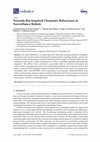
Robotics, 2016
The field of Robotics is ever growing at the same time as posing enormous challenges. Numerous wo... more The field of Robotics is ever growing at the same time as posing enormous challenges. Numerous works has been done in biologically inspired robotics emulating models, systems and elements of nature for the purpose of solving traditional robotics problems. Chromatic behaviours are abundant in nature across a variety of living species to achieve camouflage, signaling, and temperature regulation. The ability of these creatures to successfully blend in with their environment and communicate by changing their colour is the fundamental inspiration for our research work. In this paper, we present dwarf chameleon inspired chromatic behaviour in the context of an autonomous surveillance robot, "PACHONDHI". In our experiments, we successfully validated the ability of the robot to autonomously change its colour in relation to the terrain that it is traversing for maximizing detectability to friendly security agents and minimizing exposure to hostile agents, as well as to communicate with fellow cooperating robots.
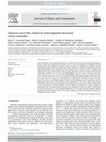
Journal of Alloys and Compounds, 2014
Carbon nanotubes and magnetite nanoparticles are materials with unique and extraordinary properti... more Carbon nanotubes and magnetite nanoparticles are materials with unique and extraordinary properties having a wider range of applications in diverse areas of science and engineering. In addition, this kind of nanomaterial can be linked to a polymeric matrix resulting in a multifunctional composite material with enhanced properties. We present here the synthesis of chitosan-starch (CH-S) films reinforced with magnetite-decorated carbon nanotubes and their properties were studied. In order to synthesize the nanocomposite material, multi-walled carbon nanotubes (MWCNTs) were first decorated with magnetite nanoparticles (MNPs) of 13.4 ± 3.7 nm using MWCNT/MNPs ratios of 0.2 and 2. Chitosan chains were used as bonding agent, and in the next step, MWCNT/MNPs was incorporated into a polymeric matrix of 70% of chitosan and 30% of starch. Concentrations of magnetite decorated MWCNT in the films were 0.1%, 0.25%, and 0.5%, respectively. Thermogravimetric and dynamic mechanical analyses were performed. The lowest concentration polymeric film showed homogeneous particle distribution, and this homogeneity was lost due to the formation of large agglomerates (%192 nm) at higher concentration. This behavior affected the physical properties of nanocomposites. Storage modulus of the film decreased as the concentration of decorated MWCNT increased indicating dependence of storage modulus on agglomerates size. The storage modulus increased in the temperature range of 150-250°C. This behavior was more pronounced at 1:3 ratios of MWCNT/MNPs due to the stronger interfacial adhesion between nanoparticles and the polymeric matrix. The magnetic behavior and electrical conductivity of the nanocomposites were also studied.
2015 10th International Conference on Information, Communications and Signal Processing (ICICS), 2015
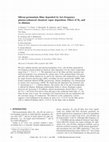
We have studied structure and electrical properties of Si 1−Y Ge Y :H films deposited by low-freq... more We have studied structure and electrical properties of Si 1−Y Ge Y :H films deposited by low-frequency plasma-enhanced chemical vapor deposition over the entire composition range from Y ס 0 to Y ס 1. The deposition rate of the films and their structural and electrical properties were measured for various ratios of the germane/silane feed gases and with and without dilution by Ar and by H 2 . Structure and composition was studied by Auger electron spectroscopy (AES), secondary ion mass spectroscopy (SIMS), and Fourier transform infrared (FTIR) spectroscopy. Surface morphology was characterized by atomic force microscopy (AFM). We found that the deposition rate increased with Y, maximizing at Y ס 1 without dilution. The relative rate of Ge and Si incorporation is affected by dilution. Hydrogen preferentially bonds to silicon. Hydrogen content decreases for increasing Y. In addition, optical measurements showed that as Y goes for 0 to 1, the Fermi level moves from mid gap to the conduction band edge; i.e., the films become more n-type. No correlation was found between the pre-exponential and the activation energy of conductivity. The behavior of the conductivity ␥-factor suggests a local minimum in the density of states at E ≈ 0.33 eV for the films grown with or without H-dilution and E ≈ 0.25 eV for the films with Ar dilution.

The viscosity property of liquids has been fully studied, capillary tubes and rotational systems ... more The viscosity property of liquids has been fully studied, capillary tubes and rotational systems are the most commonly used for reference and measurements in laboratories. However there is still interest to reduce measurement time and volume of sample measurements, as well as to simplify procedures as portable systems come to market demand and Oscillators and Vibration devices has been reported as good candidates to attend these demands, Oscillator MEMS devices require only 5uL samples and measurement is completed in only 20ms. But these devices have problems due to including mobile parts and is not often possible to use them for fluid testing. Among these candidates are the acoustic wave devices (AWD), classified into the vibration category. Using piezoelectric properties of AWD and electrostatic input signals, the output signal characteristics are related with the liquid properties, in addition AWD could be made of solidstate and can be used in fluid environment; however the senso...

MRS Proceedings, 2004
ABSTRACTIn this work, we report the composition, optical, and electrical properties of a- Si1-YGe... more ABSTRACTIn this work, we report the composition, optical, and electrical properties of a- Si1-YGeY: H, F films to be used as sensing layer in uncooled microbolometers. The a-Si1-YGeY films where Y is Ge content in solid phase were deposited by low frequency PECVD from SiH4 and GeF4 feed gases, and H2 and Ar were used for dilution. The film composition, IR transmission and temperature dependence of conductivity were measured. The reduction of conductivity activation energy from 0.86 eV to 0.39 eV and the increase of room temperature conductivity from 1x10−9 to 2.1×10−3 Ohm−1cm−1 were observed with the change of Y from 0 (Si) to 1(Ge). These results demonstrate this material to be a good candidate as a sensing material in uncooled micro-bolometers, due to its high absorption in the range of λ = 10-13 μm, its relatively high activation energy, Ea=0.4 eV, consequently, a high temperature coefficient of resistance (TCR), and moderate resistivity at room temperature.
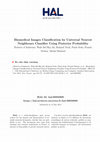
Lecture Notes in Computer Science, 2012
Universal Nearest Neighbours (unn) is a classifier recently proposed, which can also effectively ... more Universal Nearest Neighbours (unn) is a classifier recently proposed, which can also effectively estimates the posterior probability of each classification act. This algorithm, intrinsically binary, requires the use of a decomposition method to cope with multiclass problems, thus reducing their complexity in less complex binary subtasks. Then, a reconstruction rule provides the final classification. In this paper we show that the application of unn algorithm in conjunction with a reconstruction rule based on the posterior probabilities provides a classification scheme robust among different biomedical image datasets. To this aim, we compare unn performance with those achieved by Support Vector Machine with two different kernels and by a k Nearest Neighbours classifier, and applying two different reconstruction rules for each of the aforementioned classification paradigms. The results on one private and five public biomedical datasets show satisfactory performance.
2009 International Semiconductor Device Research Symposium, 2009
This work presents an analysis of a RF MEMS inductor of 3 square spirals fabricated with PolyMUMP... more This work presents an analysis of a RF MEMS inductor of 3 square spirals fabricated with PolyMUMPS technology, the final device is shown. The structure was released using wet-etching post-process in 10% TMAH at 40°C in order to optimize performance as a result of the reduced parasitic losses. The software Sonnet® was used as simulation tool and its results showed
2011 International Semiconductor Device Research Symposium (ISDRS), 2011



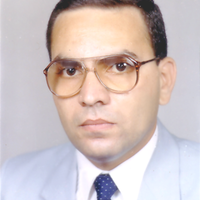



Uploads
Papers by Roberto C Ambrosio